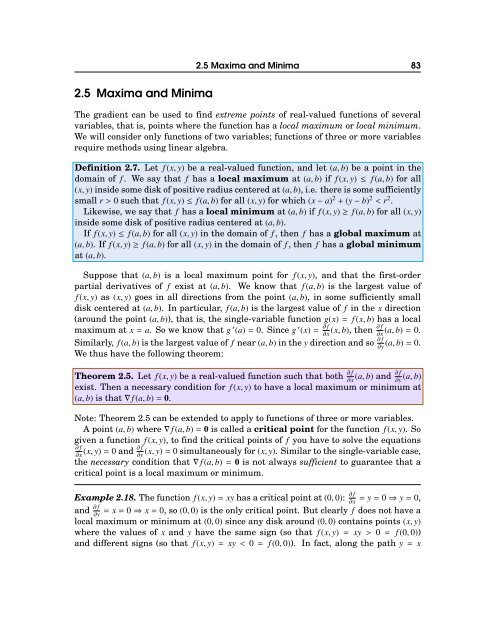Michael Corral: Vector Calculus
Michael Corral: Vector Calculus
Michael Corral: Vector Calculus
You also want an ePaper? Increase the reach of your titles
YUMPU automatically turns print PDFs into web optimized ePapers that Google loves.
2.5 Maxima and Minima 83<br />
2.5 Maxima and Minima<br />
The gradient can be used to find extreme points of real-valued functions of several<br />
variables, that is, points where the function has a local maximum or local minimum.<br />
We will consider only functions of two variables; functions of three or more variables<br />
require methods using linear algebra.<br />
Definition 2.7. Let f(x,y) be a real-valued function, and let (a,b) be a point in the<br />
domain of f. We say that f has a local maximum at (a,b) if f(x,y)≤ f(a,b) for all<br />
(x,y)insidesomediskofpositiveradiuscenteredat(a,b),i.e. thereissomesufficiently<br />
small r>0such that f(x,y)≤ f(a,b) for all (x,y) for which (x−a) 2 +(y−b) 2 < r 2 .<br />
Likewise, we say that f has a local minimum at (a,b) if f(x,y)≥ f(a,b) for all (x,y)<br />
inside some disk of positive radius centered at (a,b).<br />
If f(x,y)≤ f(a,b) for all (x,y) in the domain of f, then f has a global maximum at<br />
(a,b). If f(x,y)≥ f(a,b) for all (x,y) in the domain of f, then f has a global minimum<br />
at (a,b).<br />
Suppose that (a,b) is a local maximum point for f(x,y), and that the first-order<br />
partial derivatives of f exist at (a,b). We know that f(a,b) is the largest value of<br />
f(x,y) as (x,y) goes in all directions from the point (a,b), in some sufficiently small<br />
disk centered at (a,b). In particular, f(a,b) is the largest value of f in the x direction<br />
(around the point (a,b)), that is, the single-variable function g(x)= f(x,b) has a local<br />
maximum at x=a. So we know that g ′ (a)=0. Since g ′ (x)= ∂f<br />
∂x<br />
(x,b), then<br />
∂f<br />
∂x (a,b)=0.<br />
Similarly, f(a,b)isthelargestvalueof f near(a,b)intheydirectionandso ∂f<br />
∂y (a,b)=0.<br />
We thus have the following theorem:<br />
Theorem 2.5. Let f(x,y) be a real-valued function such that both ∂f ∂f<br />
∂x<br />
(a,b) and<br />
∂y (a,b)<br />
exist. Then a necessary condition for f(x,y) to have a local maximum or minimum at<br />
(a,b) is that∇f(a,b)=0.<br />
Note: Theorem 2.5 can be extended to apply to functions of three or more variables.<br />
A point (a,b) where∇f(a,b)=0is called a critical point for the function f(x,y). So<br />
given a function f(x,y), to find the critical points of f you have to solve the equations<br />
∂f<br />
∂x (x,y)=0and∂f ∂y<br />
(x,y)=0simultaneouslyfor(x,y). Similartothesingle-variablecase,<br />
the necessary condition that∇f(a,b)=0 is not always sufficient to guarantee that a<br />
critical point is a local maximum or minimum.<br />
Example 2.18. Thefunction f(x,y)= xyhasacriticalpointat(0,0): ∂f<br />
∂x = y=0⇒y=0,<br />
and ∂f<br />
∂y<br />
= x=0⇒ x=0, so (0,0) is the only critical point. But clearly f does not have a<br />
local maximum or minimum at (0,0) since any disk around (0,0) contains points (x,y)<br />
where the values of x and y have the same sign (so that f(x,y)= xy>0= f(0,0))<br />
and different signs (so that f(x,y)= xy








